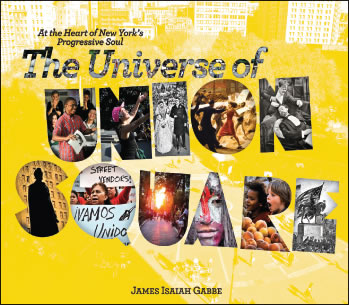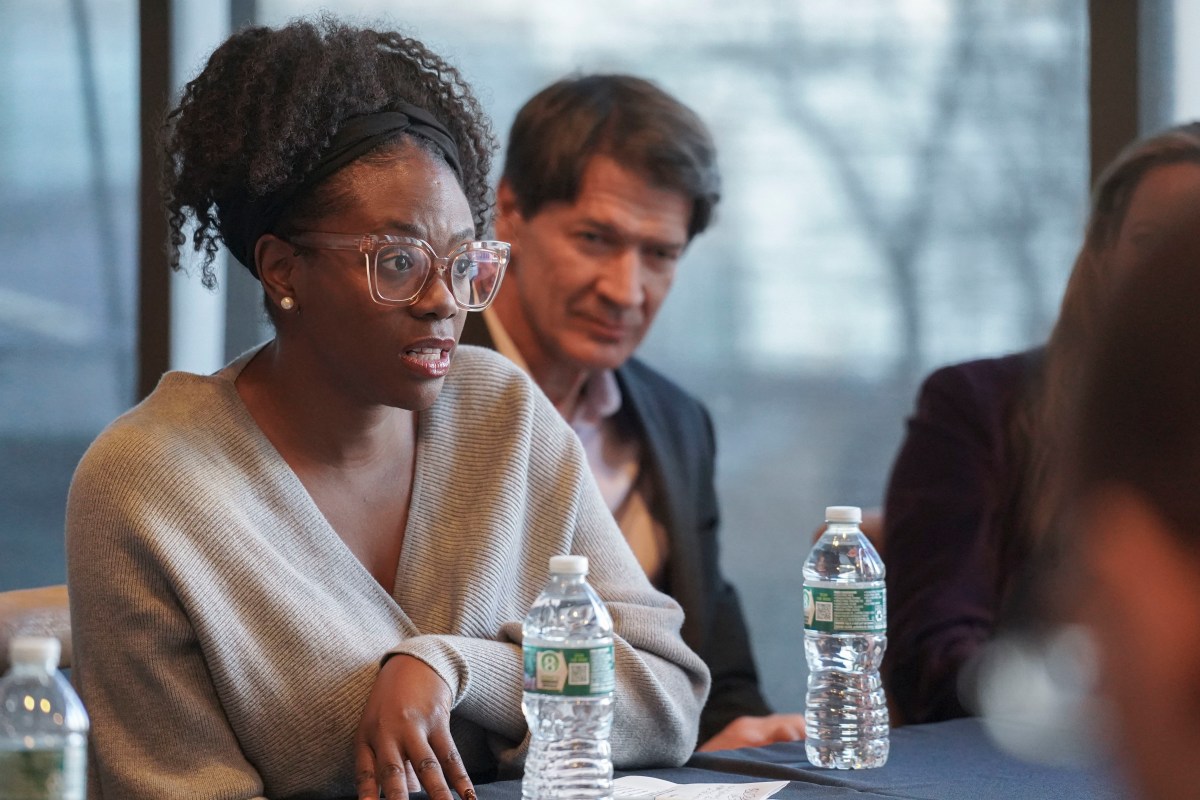By JERRY TALLMER
On Page 61 of a lavishly illustrated treasure chest of a new book called “The Universe of Union Square” there are, in newspaper lingo, a couple of tiny “thumbnail” headshots of mustachioed, bowler-hatted Butch Cassidy and the Sundance Kid.
No, not dashing golden boys Robert Redford and Paul Newman but the real McCoy — the two, real, tough-looking outlaws themselves.
How do Butch Cassidy and the Sundance Kid connect to Union Square? Well, the adjacent text tells us that Cassidy and the Kid “were said to have ducked into a 12th Street flophouse [in the crime-ridden nearby Gashouse district] as they fled to South America in 1902.”
In this loving, many-faceted historical/cultural/social chronicle, the “universe” of Union Square stretches six blocks in each direction — north, south, east, west — from Union Square Park itself. And beyond that, into the big, buzzing, complex, expanding city itself, and the even bigger and more complex nation beyond that.
Within this universe, General George Washington sits, in bronze, astride his rearing steed; brooding Abraham Lincoln delivers his never-to-be-forgotten 1860 Cooper Union address on slavery; and — in a great photograph on Page 98 — flaming anarchist Emma Goldman — all 200 pounds of her — bellows from atop a soapbox to a Union Square crowd of thousands of the unemployed that “they have a right to take bread if they are hungry” and to “demonstrate their needs before the palaces of the rich.”
“Emma Goldman — she’s my heroine, she lived right around the corner from where my wife and I live,” said James Isaiah Gabbe, the Union Square resident, business executive, man of goodwill who brought forth this book, wrote every word in it, and took the more than 700 photographs (some are by his son Benjamin) that are salted among 340 other, older visuals, dug up from the New-York Historical Society, the New York Public Library and many other sources.
Some of those present-day photographs are, of course, of the Union Square that, for some magical, emotional reason, became the nexus of suffering — and determination — on and after September 11, 2001. The hell-cloud of smoke and dust rising above the fallen Towers is preserved in a full-page photograph Jim Gabbe took from the roof of his apartment building.
Actually, said Gabbe (rhymes with babe), it was his wife, Jill, who had the idea in the first place — a modest flier supplying, to anyone passing by who cared, some of the history of Union Square, its long-ago decline and fall and, a century later, its comeback.
“You know, a nice little 24- or 28-page pamphlet — put a picture on the cover and give it away free. Shows my [then] ignorance of the history of this place. So now, three years, 4 pounds” — he hefts the book — “and 1,000 pictures later… .”
And the book is not free, though it’s a surprisingly low (by current standards) $29.95, and comes with a DVD of interviews with 60 city officials, educators, clerics, shopkeepers, writers, street people, community activists, etc., spilling their memories of Union Square.
He stressed the fact that “this book was a team effort” involving 10 or so people in and out of his firm — “helping with research, interviews, production, proofreading, fact-checking — endless, endless! — and all the rest of it.”
Did you go to Google a lot?
Gabbe rolled his eyes. “Without Google, this thing would have taken 10 years.”
His firm is gabbegroup, a public relations and marketing outfit with offices just north of the square near where Andy Warhol did his thing at The Factory.
You can rest assured that Andy Warhol is in the book, along with everybody else in theater (not least, Yiddish theater), films, painting, sculpture, “happenings,” poetry, “performance art,” whatever, who even so much as walked across Union Square Park once upon a time.
“Virtually this whole story is about people doing things, changing things, driven by that immigrant energy. ‘We’re in America, baby! We can do anything!’
The chapter headings spell it out:
Peter Stuyvesant’s Harvest
Sculpting the Square
Democracy’s Stage
Creative Cauldron
Inventive Ventures
Enlightened Streets
Expressions of Faith
Fibers of the Future
When did you switch over, Jim, from 24-page flier to 262-page, 4-pound book?
“About six weeks out, in the course of research we realized this would be much more than we had anticipated. We didn’t know how much more — just more.”
And they — or he — began to see Union Square as a sort of crossroads, an ever-changing universe, of all the other distinctive portions of Manhattan Island, starting, ca va sans dire, with Greenwich Village to the west and East Village immediately south.
I told Gabbe I was amused by the artistic license that put the Empire State and Chrysler buildings within the six-block range of this book’s Union Square.
His reply: “We talk about edifices on the square, like Con Edison, and edifices that can be seen from the square and contribute to the ambiance of this crossroads, this hodgepodge.”
For 60 or 70 years in the 20th and on into the 21st century, Union Square was pretty much a no man’s land avoided by anybody comfortably above the poverty level. I myself — if you’d asked me to close my eyes and think about Union Square — would have come up with: “Well, there’s this big empty building on the far side with a huge ‘S. KLEIN’ sign on it… .”
What was it that brought the square back to life, I asked Jim Gabbe, who has lived there with his wife and then-young two children — photographer Benjamin, now 26, and actress Bridget, now 23 — since 1987.
“Two things, both inspired by the city,” he said. “First, the Greenmarket in the square, to keep the derelicts out. Second, the granting of tax incentives to [William] Zeckendorf” — the developer of condominiums whose 26-story Zeckendorf Towers now stands where S. Klein’s once was, and of which Gabbe is an original tenant. “And then the return to the area of small businessmen and women, entrepreneurs, impresarios,” he continued. “People like Danny Meyer and his Union Square Cafe.”
Jim Gabbe has been a professional photographer since college at Northeastern University, Boston, and graduate school at Brown and Columbia. His father was in the garment business, his mother worked in management for the city of New York. Gabbe was also president of the Union Square Partnership — the business improvement district centered around the square and along 14th St. — for 10 years, from 2000 to 2010.
“This whole thing has been such an adventure,” he said of the book project. “Exploring this universe, walking around this area I’ve lived in all these years and seeing all this stuff that nobody knows about anymore.
“You know,” he said, his eyes sparkling, “the only theater with a still-untouched, preserved interior is the multiplex Cinemas Village East that was once Maurice Schwartz’s Yiddish Art Theater, at the corner of Second Avenue and 12th Street.”
Yes, this theater critic said, I know it well — or have known it well, in all its various guises since the early days of Off Broadway. Saw “Six Characters in Search of an Author” there, saw “Oh! Calcutta!” there, and many another show. But what I did not know until I came across it in Gabbe’s book, was that the Union Square Theater on 17th Street was once, long ago, the headquarters of Tammany Hall. I should have guessed, I told him, because of those great Depression-era murals on the second or third floor up over the theater.
“What?!” exclaimed James Isaiah Gabbe, his eyes once again lighting up. You could see the explorer determining to make yet another exploration.
And say, I said — babbling on — in the book there’s the briefest of references to the Cafe Royal, also at Second Avenue and 12th Street. Well, when I was a newcomer in the Village, my mentor, the great Charles Abrams, housing and civil-liberties warrior, took me one evening to the storied Cafe Royal, onetime gathering place of the Yiddish great. I remember its white-tiled floors and… .
“Stop!” said Gabbe, cutting me short. “You’re doing a didya. Making this book, we got them all the time, every day, from everybody. ‘Hey, didya know that… .’”
If you didn’t know, chances are it’s in the book. “The Universe of Union Square: At the Heart of New York’s Progressive Soul.” With photos.
James Isaiah Gabbe will be reading from and signing copies of “The Universe of Union Square,” today, Thursday, September 30, 7 p.m., at the Barnes & Noble bookstore, 33 E. 17th St., on Union Square.





































